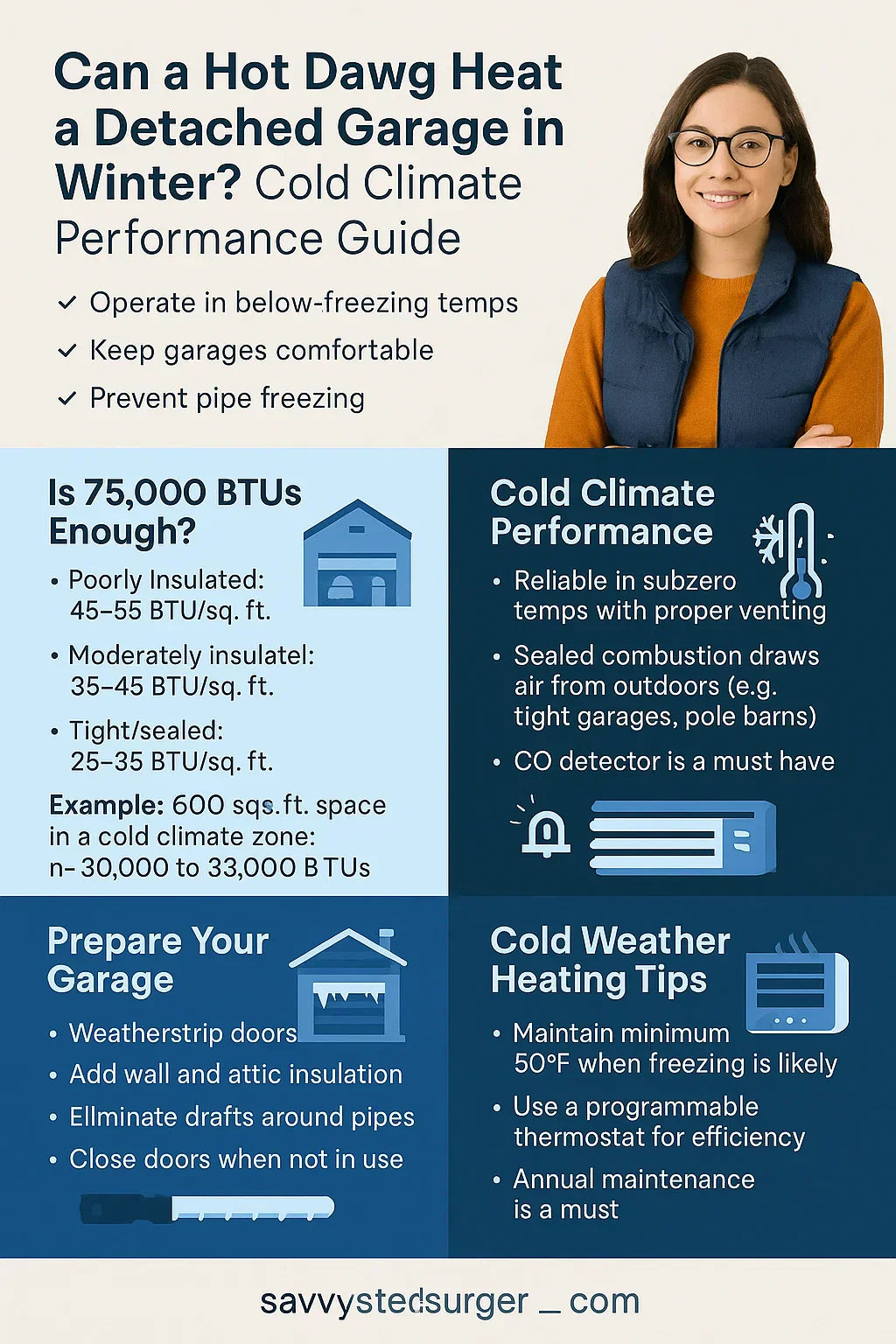Audience: Savvy homeowners evaluating whether the Modine Hot Dawg is powerful and reliable enough to keep a detached garage or workshop warm during freezing winters.
🔍 Introduction: Will It Really Work in the Dead of Winter?
Detached garages and pole barns can be challenging to heat, especially in cold climate zones like the Midwest, Northeast, or parts of Canada. If you’re considering the Modine Hot Dawg 75,000 BTU natural gas heater, the key question is:
Can it reliably heat your space—without overworking, short cycling, or freezing pipes?
This guide explores:
-
Performance of the Hot Dawg in subzero temps
-
How building type, insulation, and climate affect heat retention
-
Sizing and placement tips
-
Real-world cold climate success stories
-
Ways to winter-proof your setup
🔥 The Hot Dawg’s Cold Weather Credentials
The Modine Hot Dawg series is designed specifically for garage and workshop heating, with key features ideal for cold climates:
✅ Power-vented for efficient combustion
✅ Operates down to -40°F with proper venting
✅ 82% thermal efficiency
✅ Sealed combustion option for tight buildings
✅ Available in 30k–125k BTU sizes
📎 Modine Hot Dawg Product Specs
📍 How Cold Is “Cold”? Understanding Climate Zones
ASHRAE defines cold climate zones as:
-
Zone 5: Avg. low ~15°F (e.g., Ohio, Pennsylvania)
-
Zone 6: Avg. low ~0°F (e.g., Minnesota, Michigan)
-
Zone 7: Subzero winters (e.g., North Dakota, Maine)
In these regions, garages can drop below freezing in less than 24 hours without heat.
📐 Step 1: Is 75,000 BTUs Enough for Your Space?
Use this quick rule of thumb:
BTU needed = square footage × insulation factor
| Insulation Quality | Cold Zone Multiplier |
|---|---|
| Poor (metal walls, unsealed) | 60–70 BTU/sq ft |
| Average (R-13 walls, R-19 ceiling) | 45–60 BTU/sq ft |
| Well-insulated (spray foam, sealed) | 30–40 BTU/sq ft |
Example:
-
3-car detached garage: 30′ × 25′ = 750 sq ft
-
Average insulation in Zone 6
-
750 × 60 = 45,000 BTU (minimum input)
-
75k BTU model is ideal with margin for extreme cold
📎 LearnMetrics Garage Heater Calculator
🏗️ Step 2: Assess Your Garage’s Heat Loss
Cold climate heating success depends on reducing losses from:
-
Uninsulated ceilings: up to 50% of heat loss
-
Metal doors and gaps: major draft source
-
Concrete slab floors: cold sink
🧠 Pro tip: Add R-13 wall batts, weatherstrip the garage door, and insulate the attic for up to 40% runtime reduction.
🧪 Step 3: Modine’s Real-World Cold Climate Performance
🔧 Key Features for Freezing Temps:
-
Heavy-duty heat exchanger
-
Draft inducer for reliable combustion
-
Optional sealed combustion for tight buildings
-
Venting system designed to prevent condensate freeze
🔍 Real User Reports:
-
Minnesota user (Zone 6): "Keeps my 900 sq ft shop at 60°F even when it’s -10°F outside."
-
Maine installer: "We use Hot Dawg heaters in pole barns all winter long—solid performer down to -20°F."
🌀 Sealed vs. Open Combustion in Cold Garages
Open combustion (standard) draws air from the room. Fine in most cases.
Sealed combustion (optional kit) draws from outside—ideal for:
-
Tightly insulated garages
-
Workshops with sawdust or fumes
-
Very cold climates where inside air is too dry
📎 Modine Sealed Combustion Kit Info
🧊 Cold Weather Challenges & Solutions
| Challenge | Solution |
|---|---|
| CO risk from poor venting | Install CO detector & proper slope |
| Frost on walls/ceiling | Improve insulation & add vapor barrier |
| Frozen pipes near exterior | Keep heater near plumbing or insulate |
| Condensation on gas line | Use drip leg & insulating tape |
🔧 Best Practices for Winter-Ready Hot Dawg Setup
-
✅ Size properly (don’t undersize!)
-
✅ Use sealed combustion in tight or dusty spaces
-
✅ Run vent pipe with proper pitch and weather cap
-
✅ Use a programmable thermostat to maintain minimum temps (50–55°F)
-
✅ Install CO and smoke detectors nearby
-
✅ Check flame sensor, filter, and vent annually
💡 Energy Efficiency Tips for Cold Winters
-
Lower thermostat at night or when away
-
Use ceiling fans to circulate rising heat
-
Add a door curtain or divider for large bays
-
Consider radiant floor heat supplement (if retrofitting)
🧾 Estimated Monthly Operating Cost in Cold Zones
| Garage Size | Fuel Type | Daily Runtime | Est. Monthly Cost |
|---|---|---|---|
| 2-car (600 sq ft) | NG | 4–6 hrs | $90–$140 |
| 3-car (900 sq ft) | NG | 6–8 hrs | $150–$220 |
| 3-car w/ poor insulation | Propane | 8–10 hrs | $250–$400+ |
🔚 Conclusion: Yes, the Hot Dawg Can Handle Winter—If You Prep Smart
With proper insulation, correct sizing, and code-compliant installation, a Modine Hot Dawg 75,000 BTU heater can absolutely heat a detached garage—even in bitter cold.
✔ Pair it with a programmable thermostat
✔ Use sealed combustion for extra efficiency
✔ Follow annual maintenance routines
✔ Seal up drafts to keep that heat in
In the next topic we will read about: Is 75,000 BTUs Too Much? Sizing Your Modine Hot Dawg for Garages, Shops & Sheds







